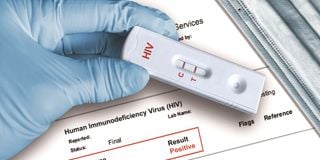Kenya records rise in new HIV infections in over a decade

HIV positive antigen test result by the rapid self testing device.
HIV infection in the country has increased for the first in ten years, a new report has shown.
The World Aids Day report 2022 to be released today indicated that the country has recorded an increase in new HIV infections for the first time in a decade with more than 2,000 cases from 32,025 to 34, 540.
Last year alone, the country recorded 34,540 HIV new cases.
The report attributes the increase in new infections to the constant new HIV infections among children, adolescents and younger people, and the shortage of HIV commodities.
The report dubbed, it is a race against time by the National Syndemic Disease Control Council revealed that of the 34,540 new cases, 70 per cent (20,505) occurred among women and girls.
Eight out of ten new HIV infections occur among adolescent girls and young women aged 15-24 raising the burden of the feminisation of the epidemic.
“Women and girls continue to bear the brunt of the epidemic. They become infected at a much earlier age than men and boys of the same age,” says the report.
It also reported that 52 per cent of all new infections occurred among adolescents and young adults aged 15-29 years with 26 per cent among 30 to 44 years, infants and children between the ages 0 to 14 contributed to 15 per cent of all the new infections with 45 and above contributing to seven per cent infections.
The infection amongst adolescents has reduced by 171 new infections from 5,294 new infections in 2020 to 5123 in 2021.
Among children
Kenya’s new HIV infections are dominant among children and younger adults below the age of 34, while the larger cohort of the people living with HIV is older adults, many of whom might have been infected at a younger age, according to the survey.
“We are off track on ending AIDS among Children, adolescents and young people in the seventh year of the 2030 Agenda for Sustainable Development Goal,” says the report.
Ten counties Nairobi, Kisumu, Homabay, Siaya, Migori, Nakuru, Mombasa Kakamega, Kisii and Uasin Gishu accounted for 57 per cent of all new HIV infections that occurred in 2021.
It was observed that Samburu, Isiolo, Wajir, Marsabit, Turkana, Lamu and Tana River increased the number of new HIV infections by more than 30 per cent between 2020 and 2021, with the highest increase occurring in Samburu County.
Most adults (85 per cent) aged 35 and above living with HIV were on treatment by the end of 2021 as compared to 66 per cent of those below the age of 34, including children.
Gender dynamics are also observed among adolescents and adults aged 15 and above with 72 per cent of men and boys living with HIV accessing treatment as compared to 80 per cent of women and girls of the same age
HIV treatment coverage is also uneven across counties. Treatment coverage for adults is lower than 70 per cent in 19 counties with Mandera and west West Pokot counties with the lowest treatment coverage of 48 per cent and 50 per cent for adults living with HIV
Kenya has a growing number of older people living with HIV due to improved access to treatment. An estimated 883,694 of the 1.4 million people living with HIV aged between 35 and 74 years many of them were diagnosed with HIV in their younger years. Between 2010 and 2021, about 622,724 deaths have been averted, attributed to ART uptake.
With the survival trends, more aged people will live with HIV over time. This means that there is a need to place more emphasis on the provision of services to protect the elderly from age-related conditions that may worsen the quality of life,” the report states.
Three counties including Nairobi, Murang’a and Kirinyaga had more than 90 per cent of adults living with HIV on antiretroviral, with 13 other counties attaining over 70 per cent coverage, and only nine counties had reached the 70 per cent mark of the estimated number of children living with HIV on treatment, Including Busia, Embu, Homabay, Isiolo, Kitui, Machakos, Makueni, Marsabit and Vihiga.
Besides HIV, other sexually transmitted infections have been on a rising trend, with 14873 pregnant mothers diagnosed with syphilis in 2021 from 10,000 in 2018.
The country did not achieve its target of reducing mother-to-child transmission of HIV to less than five per cent by 2021. While significant progress has been made the targets remain elusive. Across the country, the gains in ending new HIV infections among children have flatlined.
The use of antiretroviral for pregnant women, their partners and infants effectively interrupt the transmission of HIV during pregnancy and the breastfeeding period. Most (54.7 per cent) of the cases of mother-to-child transmission of HIV occur when an HIV-positive mother drops off ART during this period.
None of the counties had less than five per cent HIV transmission rates from mother to child, with a country average of 8.9 per cent. Some counties, including Mandera, Wajir, Marsabit, West Pokot, Isiolo, Garissa and Samburu, have high HIV mother-to-child transmission rates of 20 per cent.
The country loses about six adolescents and young people aged 15-24 daily to AIDS-related illnesses. Last year, 3,138 children aged 0 to 14 died in 2021 died of AIDS-related illnesses. With 4,098 adolescents as a result of low diagnosis and treatment.
Among children aged between zero and 14, about 31 per cent of them were undiagnosed. Of this figure, 41 per cent were not on treatment, while 45 per cent of those on treatment had not achieved viral suppression. This means that children who are not diagnosed are at risk of losing their lives, as documented evidence shows that three out of every 10 children not on antiretroviral treatment risk death after one year of life, with the risk going by their second year of life.
“The viral load suppression in children under one year is low, compromising their health, and well-being and may increase mortality. Early HIV diagnosis and treatment for children significantly reduce morbidity and mortality rates,” says the report.
Total AIDS-related deaths in 2021, inclusive of children and adolescents, stood at 22,373, which was an increase from 19, 486 recorded in 2000. Half of these deaths were recorded in Nairobi, Kisumu, Homabay, Siaya, Migori, Nakuru, and Mombasa, Kakamega, Kiambu and Kisii counties.
Kisumu County led with 1,703 Aids-related deaths, followed by Homa Bay with 1589 deaths. Nakuru came third with 1332 deaths, followed closely by Nairobi County with 1300 deaths, and Siaya with 1276 deaths. In Samburu County, the number of AIDS-related deaths shot up from 55 in 2021 to 205 in 2022.
The report states that while Kenya made efforts to reduce mother-to-child transmission, she still fell behind.
“In 2021, none of the counties had less than five per cent HIV transmission rates from mother to child, with a country average of 8.9 per cent. Some counties, including Mandera, Wajir, Marsabit, West Pokot, Isiolo, Garissa and Samburu, have high HIV mother-to-child transmission rates of 20 per cent,” says the report.
It has also been added that unwillingness of adolescents to get diagnostic services is a contributing factor to low treatment outcomes. The outcomes are also lower for boys and men as compared to women and girls.
In 2018, for example, 894, 556 boys and young men were diagnosed with HIV, with the figure rising slightly to 1, 021,778 in 2019. Meanwhile, 1, 454, 394 women and girls got diagnosed in 2018, with the figure rising to 1,779,697 in 2019.
In 2020, the figures dropped significantly, with almost half as regards boys and men. While only 578,468 of them got diagnosed, 1, 113,620 women and girls did. The figure further dwindled in 2021, with only 456, 306 boys and men getting diagnosed, as compared to 949,664 women and girls.
“Kenya has made significant investments to ensure adolescents and young people are educated, enjoy a healthy life and attain their aspirations. The overlapping challenge of new HIV infections, unintended pregnancies, and sexual and gender-based violence among children, adolescents and young women, dubbed the Triple Threat, undermines this investment’s impact. Increasing new HIV infections among adolescents and young people make it challenging to end AIDS as a public health threat in Kenya,” it states.
“Adolescent mothers diagnosed with HIV must cope with the mistimed pregnancy and initiation onto lifetime treatment during antenatal care. They are likely to be diagnosed with HIV, have poor adherence rates compared to adults, and are hence likely to transmit HIV to their babies during pregnancy and breastfeeding,” the report states.
This poor outcome is coupled with the fact that adolescent pregnancies are associated with risks of premature birth, low birth weight, perinatal death, disability, child labour, and early marriages, which increases the burden on healthcare and education.
However, the country has made significant strides in expanding access to HIV Prevention, which includes providing pre-exposure prophylaxis (PrEP) to reduce new infections among key populations at risk such as discordant couples.
Even though other key populations, including female sex workers, men who have sex with men, transgender people and people who inject drugs have increased, new HIV infections have reduced from 33 per cent in 2009 to 13 per cent in 2020. This is all thanks to a programme that has targeted these key groups for the last decade.






